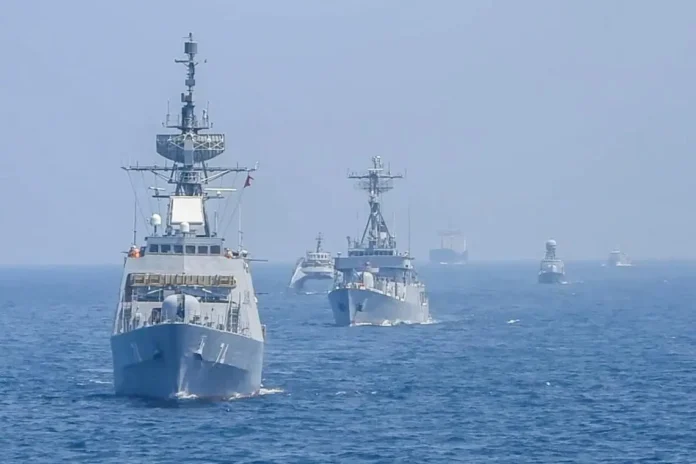Are China, the Philippines and the United States heading for military conflict?
Hong Liuxing and Adam N. Lee, chinaworker.info
Recent months have seen a sharp escalation of the dispute between the Philippines and China for sovereignty over islands and ‘features’ – often no more than rocks – in the South China Sea, which is called the West Philippines Sea by the Manila government. Coast guard vessels from the two sides have sparred using water cannons, lasers, and in at least one case ramming. China often uses ‘grey zone’ tactics that stop short of what would be considered an armed attack, which could trigger the US-Philippines mutual defense treaty.
Both governments have economic but also political and reputational reasons to adopt a hardline in their maritime disputes. Four other governments (Brunei, Malaysia, Taiwan and Vietnam) also lay claim to some or all of the island groups in the South China Sea. Taking control of the islands, which are not populated, lends support to a government’s legal claims over the surrounding waters, with their fishing stocks and the potentially huge mineral reserves under the sea bed.
Actual ‘ownership’ is mostly disputed and not recognised under any international treaties or laws. The Chinese regime’s nine-dash-line (recently expanded to ten), which stakes a claim to 90 percent of the South China Sea, was rejected by a 2016 international tribunal in The Hague. Beijing refused to recognise the verdict. This gifted the US government with a certain propaganda weapon to portray China’s actions as “illegal”, while ironically the US itself refuses to sign the very treaty (UNCLOS) which served as the basis for the tribunal’s ruling.
Military considerations topmost
Mostly, these disputes have a geostrategic and military dimension, outweighing their economic ambitions. With the election to the presidency of Ferdinand Marcos Jr, who is the son of the late US-sponsored dictator, the Philippines has tilted from China back towards the US, its traditional military ally, in the ongoing imperialist Cold War. This is a sharp reversal from the policies of his predecessor in the Malacañang Palace, the “Asian Trump” Rodrigo Duterte, who cosied up to Xi Jinping and tried to straddle a line of sorts between the two superpowers.
Since 2019, the Trump and Biden administrations have stated that the Philippines’ claims in the disputed areas fall under the US Mutual Defense Treaty with Manila (the oldest alliance in the region). During the latest escalation of hostilities, the US has taken its rhetoric a level higher. In late October, Biden warned Beijing that the US defence pact includes any attacks on Philippines’ vessels, raising the possibility that US forces could intervene to support the Philippines when its boats are harassed by China’s coast guard. “Any attack on the Filipino aircraft, vessels, or armed forces will invoke our Mutual Defense Treaty with the Philippines,” the US president said.
The background to these conflicts is the so-called ‘first island chain’ naval strategy of US imperialism for the containment of China (and Russia), which originated during the Korean War at the outset of the original Cold War of Western capitalism vs. Stalinism. There is no doubt today that Biden’s government, the US military, and other regional actors such as Japan, are encouraging the new Filipino government to more defiantly challenge China over the contested territories.
Dangerous dynamic
This tactic contains a number of dangers. There is plenty of scope for crossed wires and even for the ‘puppet’ to engage in activity that blows back against the ‘puppetmaster’. The nightmare challenges for US imperialism in the Middle East, which currently teeters on the edge of a possible regional war, and shows that Washington’s control over the far-right Israeli regime is at best only partial, illustrate where today’s dynamic in East Asia could lead.
Previously, we have discussed how the US-China imperialist power struggle might encounter its first direct battleground in the East or South China Seas. Under certain conditions, one or other of the regimes might calculate that this offers the best stage to teach the other side a military ‘lesson’, to force it to back down, while not carrying the same risk of an out-of-control escalation.
There are no civilian populations on the disputed islands, and therefore little risk of direct ‘collateral damage’ that could build pressure for wider military action. This possible scenario is therefore less risky, a general staff might conclude, than launching – or repelling – an invasion of Taiwan for example. For the reasons explained above, however, all such possible scenarios are full of dangers that could backfire on their instigators. The conflict in the South China Sea can only be fully understood as a corollary to the struggle to control Taiwan, with both imperialist powers playing out a strategic chess game to strengthen their positions.
Marxists oppose China’s military expansion in the region, and we oppose US imperialism’s so-called “freedom of navigation exercises’’, which are also blatant imperialist acts of aggression. We stand for joint democratic control of the South China Sea by the peoples of the bordering states and other neighbouring countries, to fully demilitarize, jointly administer, protect and develop the ocean’s natural resources. Such a peaceful win-win solution is impossible under capitalist regimes, which is why the conflict is escalating today even as the oceans and their marine life are being rapidly killed off by capitalist climate change and overexploitation.
Socialist federation
Only through a socialist federation of East Asia based on equal and democratic rights, would it be possible to end this destructive cycle. Ultimately, capitalism’s scramble for resources – gas, oil, fish – takes second place to the furious contest over military space and positioning for a future war between the US and China.
This is also about whether China can become a ‘blue water navy’ – to be able to project global power like the US does outside of its region, which is evidently Beijing’s aim. Therefore any war over the South China Sea would not primarily be a resource war but a battle for military hegemony.
More than a decade ago (before Xi Jinping came to power) China began to assert its maritime claims more aggressively. We saw a massive project of artificial island building – the “Great Wall of Sand” – where military bases have been built. Other claimant states engage in similar activity, just not on a comparable scale. Clashes over fishing rights also broke out with the Philippines, for example in 2012, when China snatched control of the Scarborough Shoal (Huangyan Island) from Manila.
In the same year, under Hu Jintao, the Senkaku/Diaoyu Islands conflict erupted, which stoked massive nationalist protests between Japan and China. This incident included some protests in China that got out of the control of the regime. But these were fundamentally reactionary militarist protests. It is out of this conflict that the Quad (Quadrilateral Security Dialogue), founded in 2007, began to take on flesh. Japan’s Abe pushed for a “democratic security diamond” of Japan, India, the US and Australia against China.
Duterte, like many leaders in the Global South, was attracted to China’s debt-financed infrastructure plan, the Belt and Road Initiative (BRI). At Beijing’s Great Hall of the People, the former Philippines president delighted CCP dignitaries when he declared: “In this venue, your honors, I announce my separation from the United States, both in military, not maybe social, but economics also… maybe I will also go to Russia to talk to Putin and tell him that there are three of us against the world, China, Philippines and Russia.”
Belt and Road losing momentum
That was in 2016. Two years later, only 160 million dollars worth of projects had actually broken ground. Today, the Philippines’ reset into the US orbit is really a form of imperialist blowback. In October, the Marcos government announced it was ending cooperation with China’s BRI over three large railway projects and would turn instead to Japan and India for finance.
While not a formal or complete exit from the BRI, this step is a significant reputational blow to Xi’s regime. At the 10th anniversary BRI summit in Beijing, also in October, Marcos did not attend. In fact, only 23 world leaders turned up to the summit, down from 37 five years earlier.
Furthermore, despite on one level trying to woo the Philippines away from the US camp, China’s navy and coastguards didn’t stop harassing Filipino fishermen, actions that may have played well to nationalist audiences in China. So even before Marcos took power, Duterte had already begun moving away from China.
Early in 2023, the Biden administration scored a significant win against China with the granting of four new military bases in northern Philippines. Think of these basically as unsinkable US aircraft carriers. Again we saw the South China Sea feature centrally when Biden met with South Korea’s Yoon and Japan’s Kishida in August 2023. The three leaders reaffirmed the 2016 Hague ruling against China’s nine-dash line. Indian leader Modi also committed to upholding this decision, which is the first time the Indian government has taken such a stand.
The CCP regime’s build-up in the South China Sea (and similar moves in the East China Sea) is part of a strategy to “gradually erode” the claims of other regional states – Philippines, Malaysia, Vietnam – with the main aim to make it more difficult for US imperialism to project power and ultimately to wage war against China from the sea.
While this might make sense from the standpoint of military logic, politically it has been completely counterproductive. If anything, China’s militarization of the sea is driving other regional governments into the hands of the US. This is not just in the case of the Philippines, but also Vietnam and Indonesia (which has disputes with China just outside the South China Sea over the Natuna Islands). The Indonesian and Malaysian governments recently negotiated their sea claims out, so that they no longer contradict with each other, but still with China’s.
These processes are also taking place in a completely new context. As shown by Ukraine, and Israel’s war on Gaza, state-to-state military conflicts today are taking on a qualitatively more complex and ‘globalized’ character due to the new Cold War between US and Chinese imperialism.
US imperialism stretched
There are also serious problems for US imperialism in this arena, even before Israel launched its war on Gaza, which has demanded a response from “the world’s policeman” to redeploy military assets to the Middle East, from whence it has been trying to shift forces to the ‘Indo-Pacific’. Even as the world’s top military power, the US risks being spread too thinly by a three-way drag on its resources (Ukraine, Israel and Taiwan).
China’s military has an obvious advantage in that the contested zone is close to its coast, while the US must deploy over long distances. Chinese shipbuilding capacity is also three to one vs. the US. This contradicts the often quoted official figures about Chinese military spending as much smaller than the US. In reality China’s spending is far higher than the declared number, possibly US$700 billion a year instead of the official US$300 billion
This is because of the CCP’s “military-civilian fusion”, whereby many private companies that produce civilian goods are also defense contractors. One example of this are the gigantic “floating carparks” container ships currently being built to export China’s vast overcapacity in electric vehicles. These container ships could also be used to carry large amounts of tanks and other military hardware in the event of an invasion of Taiwan.
While the US military position is threatened by China in this region, the real naval military balance of the two powers is still in question before it is tested in a real fight. A 2021 article, ‘Yes, The Chinese Navy Has More Ships Than The US Navy. But It’s Got Far Fewer Missiles’ published by Sagamore Institute, a US think tank, argued that there’s more to the comparison than the number of hulls. The real number in the competition is the number of missile tubes, and the US navy theoretically can carry more than double the missiles of China’s fleet.
These are the grotesquely skewed priorities of capitalism. The AUKUS pact of the US together with Britain and Australia is another example. The entire region around the South China Sea is being militarized to the hilt. The 10-member ASEAN bloc has doubled its yearly arms budgets this century to US$43.2 billion. That sum is equivalent to three times the Philippines’ education budget – a country where a fifth of children don’t go to school.
The climate crisis is also severe in the South China Sea. More than 500 coral reefs have died out or suffered irreversible degradation in recent years as a result of rising sea temperatures. This sea provides food for millions but the mass of some fish and marine species is on track to shrink 90 percent by 2050 based on current global climate trends.
Marxists in all the countries of the region must try to initiate and lead struggles against nationalism, capitalism and imperialism. And to build a workers’ and oppressed people’s political alternative to fight for international socialism.




